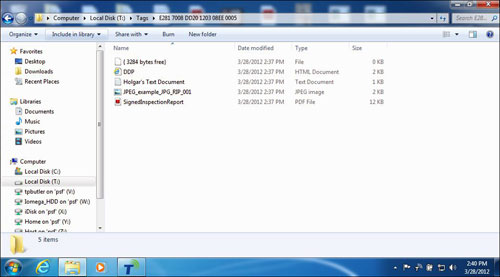With a new software solution from Tego, users can plug an RFID reader into a computer’s USB port, and then read or write data to a tag as though it were another file on their desktop. According to the company, the solution, known as TegoDrive, is standards-based and works with passive RFID tags and chips, regardless of memory size.
By clicking and dragging tag icons, an RFID system user can capture RFID tag data and store it in various files and documents, as well as write copies of existing files on a PC or laptop directly onto an RFID tag. Whenever a tag is detected, Tego reports, it automatically appears on the computer as a folder, and changing the Electronic Product Code (EPC) becomes as simple an operation as renaming the folder. Once the tag is interrogated, its user memory appears as files within that folder, allowing data to be written from existing applications with no modification necessary, other than changing the save location from the PC to the tag, or from tag to PC.

To view a larger version of the above image, click here.
To store data on a tag, a user would drag and drop a file—such as an individual’s badge number and name (for an ID badge system)—onto the tag, or save the file directly onto that tag.
The TegoDrive software is invisible to end users, the company explains, with just a small system-notification icon appearing on a computer’s screen to indicate when the program is reading or encoding a tag. The software makes Microsoft‘s Windows or Apple‘s Mac operating system become the reader program, with the reader working similarly to a memory stick or a thumb drive, onto which a user can store any data from any program—in this case, onto the tag.
Because tag data is managed as regular files in folders, entire files can be stored on a tag, including files in .pdf, .jpg, .html, .txt or some other format. Those files could then be copied onto another user’s laptop, handheld device or PC. The technology is currently being beta-tested at several unnamed user sites.
Tego plans to sell kits—including a third-party reader, as well as EPC Gen 2 passive ultrahigh-frequency (UHF) tags made with Tego’s high-memory TegoChip RFID chips—at a price below $1,000. The company also intends to offer the TegoDrive software without a reader, at a cost compatible with typical office application software. Users of the technology have a short list of steps to follow in order to get the software up and running on their computer, Tego reports—after reading a one-page quick-start guide, a user can plug the reader into the USB drive of a computer or handheld and install the software. Once installation is complete, he or she can then start saving data to a tag, or retrieving information already stored on it.
Tim Butler, Tego’s president and CEO, notes that the new solution will “transform the way users look at RFID,” from a separate technology requiring integration with other hardware and software “to a seamless extension of their existing networks and data.”
The solution “will enable a much broader use case beyond the traditional supply chain,” Butler says. “We think people will come up with some pretty interesting ways to use this.” The TegoDrive software will operate with a variety of third-party RFID handheld or desktop readers, as well as standards-based UHF, low-frequency (LF) or high-frequency (HF) passive RFID tags, ranging from low-memory tags with a storage capacity of 521 bits or less to high-memory tags with 2 kilobits to 24 kilobytes of memory. Tego also offers free simulation software that provides users with the ability to try the system, by simulating the use of RFID tags containing the TegoDrive software to write data to those tags, and to then read that information.
“Our goal is to provide new ways for people to use RFID,” Butler says, as well as to make the reading process as easy as possible. He envisions small and midsize companies utilizing the technology to read and encode tags in, for example, the chemical industry, at nuclear facilities (to track data regarding a part or tool on which a tag is attached) or the health-care sector (to track vials, assets, or personnel and patients).
What’s more, the company adds, TegoDrive provides users with additional benefits, such as a complete and auditable history of changes or additions to tag data, including the ability to resurrect the information as it existed on a defined date or at a specified time; to split tags into multiple memory segments, so that different organizations can have their own region; and to encrypt and authenticate sensitive data (NSA Suite B), in order to prevent the cloning of tags or the counterfeiting of data or author.
The TegoDrive system will be exhibited for the first time at RFID Journal LIVE! 2012, being held this week in Orlando, Fla.

